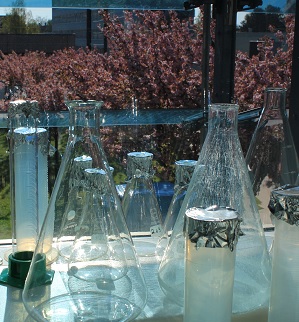publications
Top 5 Publications
Kastritis PL*, O’Reilly FJ* et al. Capturing protein communities by structural proteomics in a thermophilic eukaryote. Mol Sys Biol. 2017;13: 936.[The article was highlighted as the cover in Mol Sys Biol. We applied cryo-EM, proteomics, chemical cross-linking, network biology and computer modeling and were able to elucidate the structural basis of interactions within cellular extracts of C. thermophilum. Using the stability of the organism, we were able to resolve the high-resolution structure of fatty acid synthase at 4.7 Å from cell extracts and its involvement in a metabolon with a carboxylase. HALOmem can apply this method to understand enzymatic interactions in eukaryotic cells using biochemistry, computer modeling, electron microscopy and data analysis].
Visscher KM*, Kastritis PL*, Bonvin AM. Non-interacting surface solvation and dynamics in protein-protein interactions. Proteins. 2015;83(3):445-58.[This article describes molecular dynamics simulations on transient complexes to understand contributions of solvation and flexibility to the binding affinity. Distant effects from the outer surfaces contribute significantly to the biophysics of complexation for a variety of protein complexes. Simulations can be applied to modelled interfaces of cellular metabolons to understand biophysical contributors to weak interactions between enzymes and how these change upon mutation or between species].
Kastritis PL et al. Proteins feel more than they see: fine-tuning of binding affinity by properties of the non-interacting surface. J Mol Biol. 2014;426(14):2632-52.[In this seminal work of our group (cited in F1000 as exceptional), we analyzed biophysical contributions to the binding affinity of >150 transient complexes with experimentally-verified binding affinities. We determined several novel contributors, mainly long-range electrostatics and solvation effects stemming from the non-interacting surfaces of these interactions. Such calculations and the model proposed can be applied to understand the weak nature of enzyme complexes involved in higher-order assemblies in metabolism and quantitatively calculate their (native and mutant) binding affinities, predicting which interactions are more stable].
Kastritis PL, Rodrigues JP, Bonvin AM. HADDOCK(2P2I): a biophysical model for predicting the binding affinity of protein-protein interaction inhibitors. J Chem Inf Model. 2014;54(3):826-36.[In this article, we derived a robust model to predict the binding affinity of small molecules that aim to disrupt or modulate protein-protein interfaces. Therefore, this program and the developed scoring function can be applied for computational structure-based design of small molecules to e.g. affect metabolon formation in various metabolic pathways].
Kastritis PL et al. Solvated protein-protein docking using Kyte-Doolittle-based water preferences. Proteins. 2013;81(3):510-8.[A robust, flexible docking simulation has been developed in which the solvent is explicitly considered. Proteins are flexibly docked within their solvation shells and hydrophobic effect is simulated by randomly displacing water molecules from the formed interfaces using a hydrophobicity potential I derived from amino acid biophysics. This protocol can be directly used to dock and consequently understand binding modes of metabolons, where solvent effects in such transient interactions must play major roles].





